Management and Operation: Leader, Manager Roles, and Theories Analysis
VerifiedAdded on 2021/02/21
|16
|4780
|48
Report
AI Summary
This report delves into the distinct roles and characteristics of leaders and managers, highlighting their functions within an organization. It contrasts leadership and management styles, exploring how they apply in various business scenarios. The report examines leadership theories such as situational and contingency leadership, illustrating their practical applications. Furthermore, it analyzes key approaches to operational management and assesses the impact of the business environment on operational decisions. The report uses Tesco as a case study to demonstrate how leaders and managers can address challenges like competition and cost control, emphasizing the importance of operational management in meeting business objectives. This report provides a comprehensive overview of leadership, management, and their practical application within a business context.
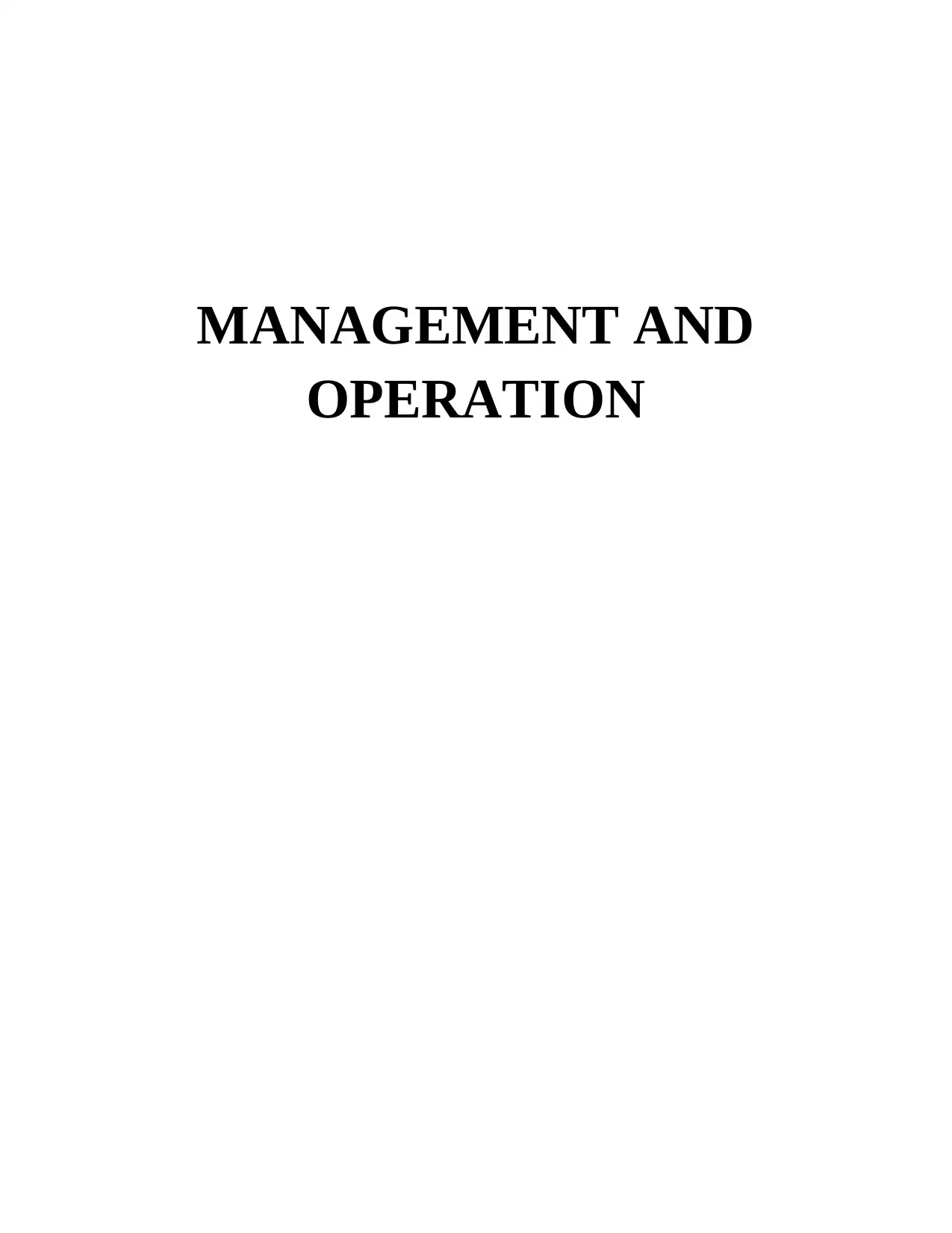
MANAGEMENT AND
OPERATION
OPERATION
Paraphrase This Document
Need a fresh take? Get an instant paraphrase of this document with our AI Paraphraser
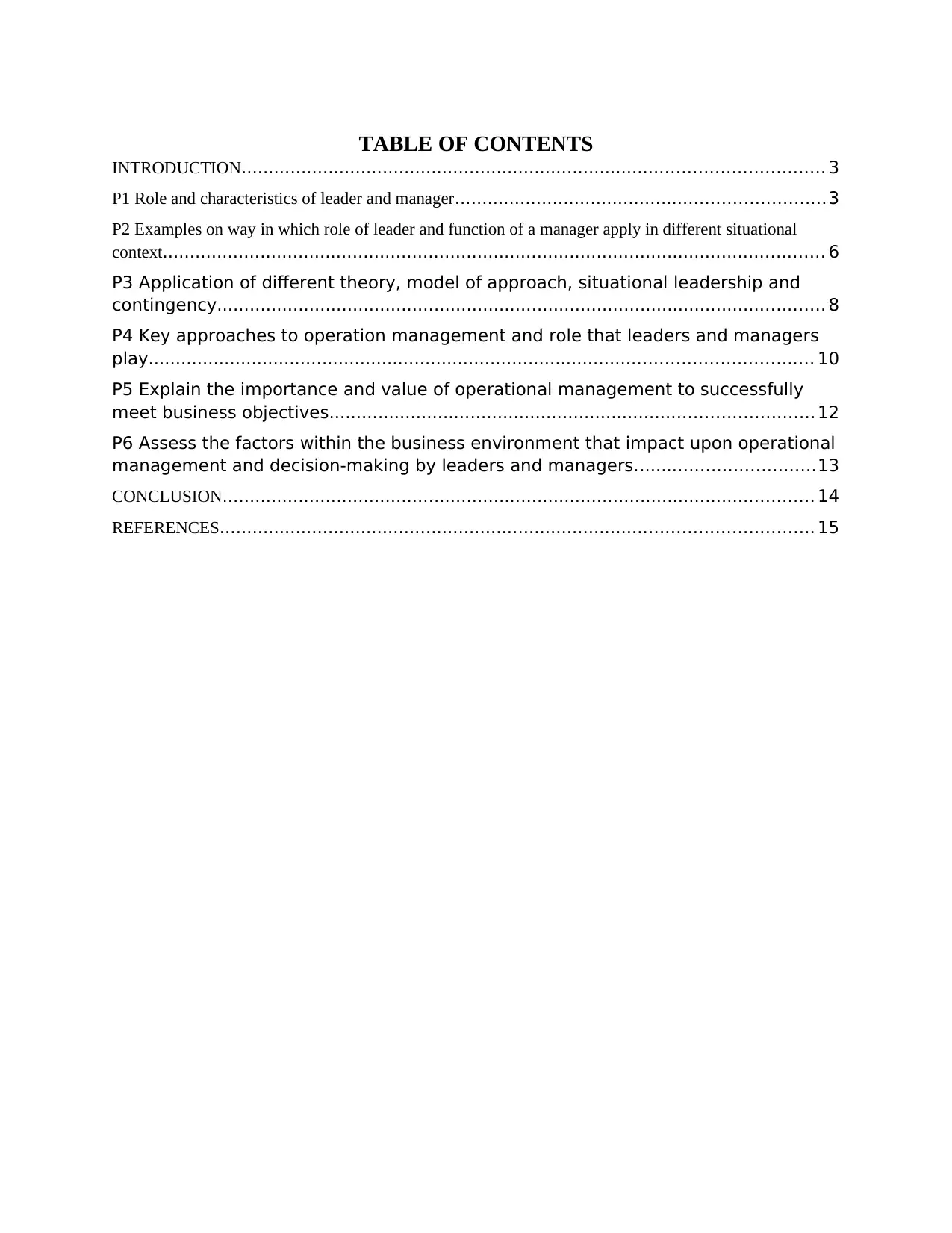
TABLE OF CONTENTS
INTRODUCTION........................................................................................................... 3
P1 Role and characteristics of leader and manager....................................................................3
P2 Examples on way in which role of leader and function of a manager apply in different situational
context.......................................................................................................................... 6
P3 Application of different theory, model of approach, situational leadership and
contingency................................................................................................................ 8
P4 Key approaches to operation management and role that leaders and managers
play.......................................................................................................................... 10
P5 Explain the importance and value of operational management to successfully
meet business objectives......................................................................................... 12
P6 Assess the factors within the business environment that impact upon operational
management and decision-making by leaders and managers.................................13
CONCLUSION............................................................................................................. 14
REFERENCES............................................................................................................. 15
INTRODUCTION........................................................................................................... 3
P1 Role and characteristics of leader and manager....................................................................3
P2 Examples on way in which role of leader and function of a manager apply in different situational
context.......................................................................................................................... 6
P3 Application of different theory, model of approach, situational leadership and
contingency................................................................................................................ 8
P4 Key approaches to operation management and role that leaders and managers
play.......................................................................................................................... 10
P5 Explain the importance and value of operational management to successfully
meet business objectives......................................................................................... 12
P6 Assess the factors within the business environment that impact upon operational
management and decision-making by leaders and managers.................................13
CONCLUSION............................................................................................................. 14
REFERENCES............................................................................................................. 15
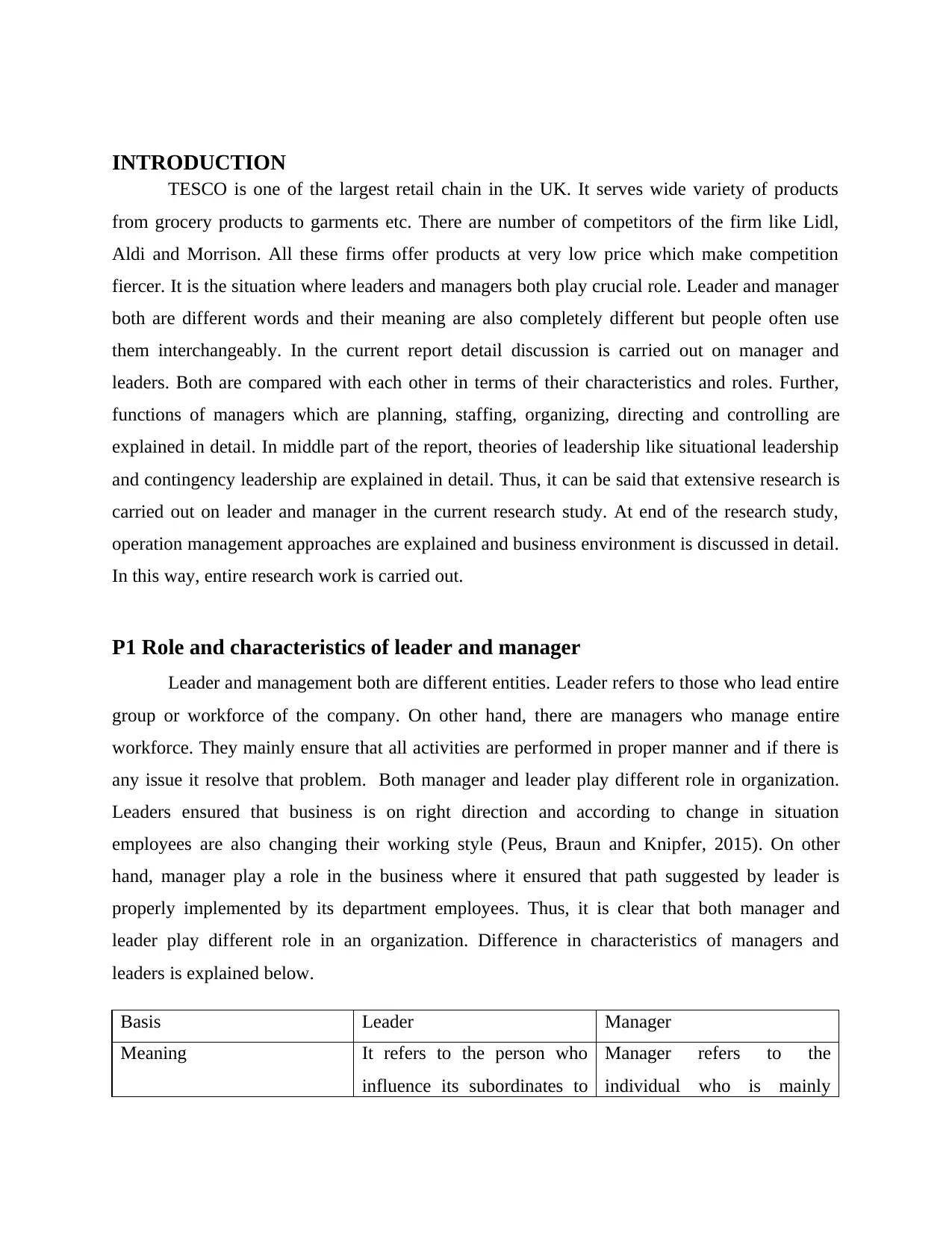
INTRODUCTION
TESCO is one of the largest retail chain in the UK. It serves wide variety of products
from grocery products to garments etc. There are number of competitors of the firm like Lidl,
Aldi and Morrison. All these firms offer products at very low price which make competition
fiercer. It is the situation where leaders and managers both play crucial role. Leader and manager
both are different words and their meaning are also completely different but people often use
them interchangeably. In the current report detail discussion is carried out on manager and
leaders. Both are compared with each other in terms of their characteristics and roles. Further,
functions of managers which are planning, staffing, organizing, directing and controlling are
explained in detail. In middle part of the report, theories of leadership like situational leadership
and contingency leadership are explained in detail. Thus, it can be said that extensive research is
carried out on leader and manager in the current research study. At end of the research study,
operation management approaches are explained and business environment is discussed in detail.
In this way, entire research work is carried out.
P1 Role and characteristics of leader and manager
Leader and management both are different entities. Leader refers to those who lead entire
group or workforce of the company. On other hand, there are managers who manage entire
workforce. They mainly ensure that all activities are performed in proper manner and if there is
any issue it resolve that problem. Both manager and leader play different role in organization.
Leaders ensured that business is on right direction and according to change in situation
employees are also changing their working style (Peus, Braun and Knipfer, 2015). On other
hand, manager play a role in the business where it ensured that path suggested by leader is
properly implemented by its department employees. Thus, it is clear that both manager and
leader play different role in an organization. Difference in characteristics of managers and
leaders is explained below.
Basis Leader Manager
Meaning It refers to the person who
influence its subordinates to
Manager refers to the
individual who is mainly
TESCO is one of the largest retail chain in the UK. It serves wide variety of products
from grocery products to garments etc. There are number of competitors of the firm like Lidl,
Aldi and Morrison. All these firms offer products at very low price which make competition
fiercer. It is the situation where leaders and managers both play crucial role. Leader and manager
both are different words and their meaning are also completely different but people often use
them interchangeably. In the current report detail discussion is carried out on manager and
leaders. Both are compared with each other in terms of their characteristics and roles. Further,
functions of managers which are planning, staffing, organizing, directing and controlling are
explained in detail. In middle part of the report, theories of leadership like situational leadership
and contingency leadership are explained in detail. Thus, it can be said that extensive research is
carried out on leader and manager in the current research study. At end of the research study,
operation management approaches are explained and business environment is discussed in detail.
In this way, entire research work is carried out.
P1 Role and characteristics of leader and manager
Leader and management both are different entities. Leader refers to those who lead entire
group or workforce of the company. On other hand, there are managers who manage entire
workforce. They mainly ensure that all activities are performed in proper manner and if there is
any issue it resolve that problem. Both manager and leader play different role in organization.
Leaders ensured that business is on right direction and according to change in situation
employees are also changing their working style (Peus, Braun and Knipfer, 2015). On other
hand, manager play a role in the business where it ensured that path suggested by leader is
properly implemented by its department employees. Thus, it is clear that both manager and
leader play different role in an organization. Difference in characteristics of managers and
leaders is explained below.
Basis Leader Manager
Meaning It refers to the person who
influence its subordinates to
Manager refers to the
individual who is mainly
⊘ This is a preview!⊘
Do you want full access?
Subscribe today to unlock all pages.

Trusted by 1+ million students worldwide
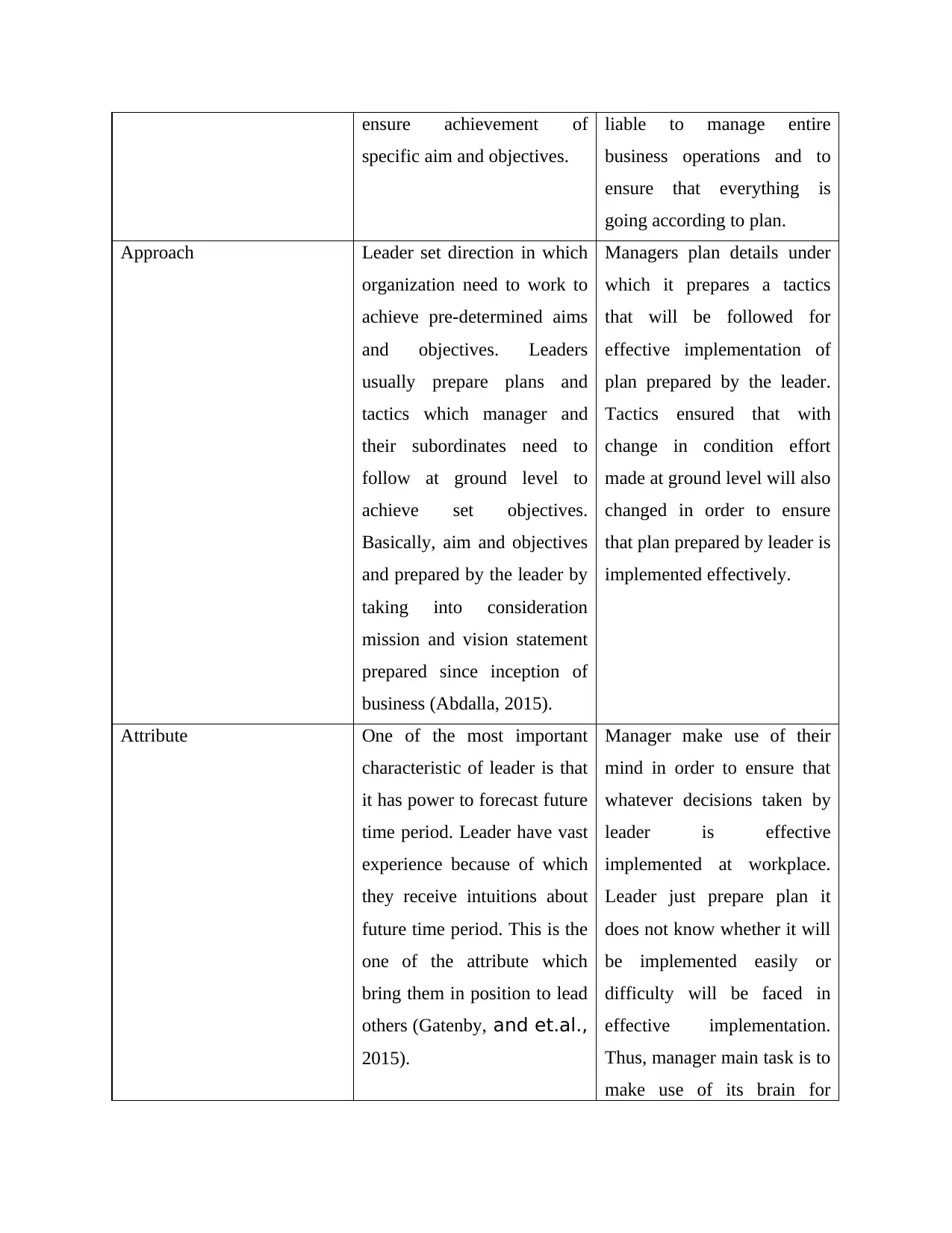
ensure achievement of
specific aim and objectives.
liable to manage entire
business operations and to
ensure that everything is
going according to plan.
Approach Leader set direction in which
organization need to work to
achieve pre-determined aims
and objectives. Leaders
usually prepare plans and
tactics which manager and
their subordinates need to
follow at ground level to
achieve set objectives.
Basically, aim and objectives
and prepared by the leader by
taking into consideration
mission and vision statement
prepared since inception of
business (Abdalla, 2015).
Managers plan details under
which it prepares a tactics
that will be followed for
effective implementation of
plan prepared by the leader.
Tactics ensured that with
change in condition effort
made at ground level will also
changed in order to ensure
that plan prepared by leader is
implemented effectively.
Attribute One of the most important
characteristic of leader is that
it has power to forecast future
time period. Leader have vast
experience because of which
they receive intuitions about
future time period. This is the
one of the attribute which
bring them in position to lead
others (Gatenby, and et.al.,
2015).
Manager make use of their
mind in order to ensure that
whatever decisions taken by
leader is effective
implemented at workplace.
Leader just prepare plan it
does not know whether it will
be implemented easily or
difficulty will be faced in
effective implementation.
Thus, manager main task is to
make use of its brain for
specific aim and objectives.
liable to manage entire
business operations and to
ensure that everything is
going according to plan.
Approach Leader set direction in which
organization need to work to
achieve pre-determined aims
and objectives. Leaders
usually prepare plans and
tactics which manager and
their subordinates need to
follow at ground level to
achieve set objectives.
Basically, aim and objectives
and prepared by the leader by
taking into consideration
mission and vision statement
prepared since inception of
business (Abdalla, 2015).
Managers plan details under
which it prepares a tactics
that will be followed for
effective implementation of
plan prepared by the leader.
Tactics ensured that with
change in condition effort
made at ground level will also
changed in order to ensure
that plan prepared by leader is
implemented effectively.
Attribute One of the most important
characteristic of leader is that
it has power to forecast future
time period. Leader have vast
experience because of which
they receive intuitions about
future time period. This is the
one of the attribute which
bring them in position to lead
others (Gatenby, and et.al.,
2015).
Manager make use of their
mind in order to ensure that
whatever decisions taken by
leader is effective
implemented at workplace.
Leader just prepare plan it
does not know whether it will
be implemented easily or
difficulty will be faced in
effective implementation.
Thus, manager main task is to
make use of its brain for
Paraphrase This Document
Need a fresh take? Get an instant paraphrase of this document with our AI Paraphraser
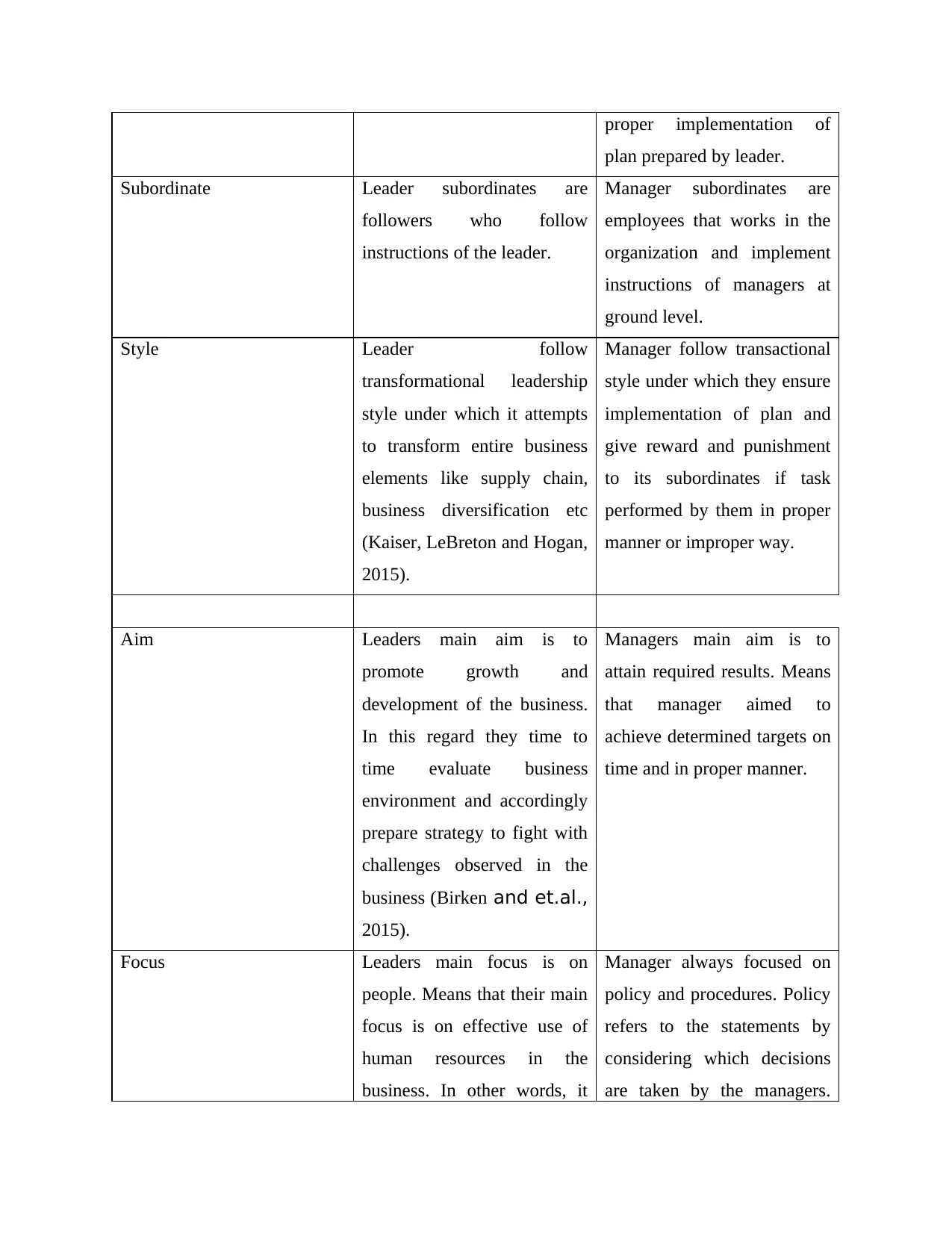
proper implementation of
plan prepared by leader.
Subordinate Leader subordinates are
followers who follow
instructions of the leader.
Manager subordinates are
employees that works in the
organization and implement
instructions of managers at
ground level.
Style Leader follow
transformational leadership
style under which it attempts
to transform entire business
elements like supply chain,
business diversification etc
(Kaiser, LeBreton and Hogan,
2015).
Manager follow transactional
style under which they ensure
implementation of plan and
give reward and punishment
to its subordinates if task
performed by them in proper
manner or improper way.
Aim Leaders main aim is to
promote growth and
development of the business.
In this regard they time to
time evaluate business
environment and accordingly
prepare strategy to fight with
challenges observed in the
business (Birken and et.al.,
2015).
Managers main aim is to
attain required results. Means
that manager aimed to
achieve determined targets on
time and in proper manner.
Focus Leaders main focus is on
people. Means that their main
focus is on effective use of
human resources in the
business. In other words, it
Manager always focused on
policy and procedures. Policy
refers to the statements by
considering which decisions
are taken by the managers.
plan prepared by leader.
Subordinate Leader subordinates are
followers who follow
instructions of the leader.
Manager subordinates are
employees that works in the
organization and implement
instructions of managers at
ground level.
Style Leader follow
transformational leadership
style under which it attempts
to transform entire business
elements like supply chain,
business diversification etc
(Kaiser, LeBreton and Hogan,
2015).
Manager follow transactional
style under which they ensure
implementation of plan and
give reward and punishment
to its subordinates if task
performed by them in proper
manner or improper way.
Aim Leaders main aim is to
promote growth and
development of the business.
In this regard they time to
time evaluate business
environment and accordingly
prepare strategy to fight with
challenges observed in the
business (Birken and et.al.,
2015).
Managers main aim is to
attain required results. Means
that manager aimed to
achieve determined targets on
time and in proper manner.
Focus Leaders main focus is on
people. Means that their main
focus is on effective use of
human resources in the
business. In other words, it
Manager always focused on
policy and procedures. Policy
refers to the statements by
considering which decisions
are taken by the managers.
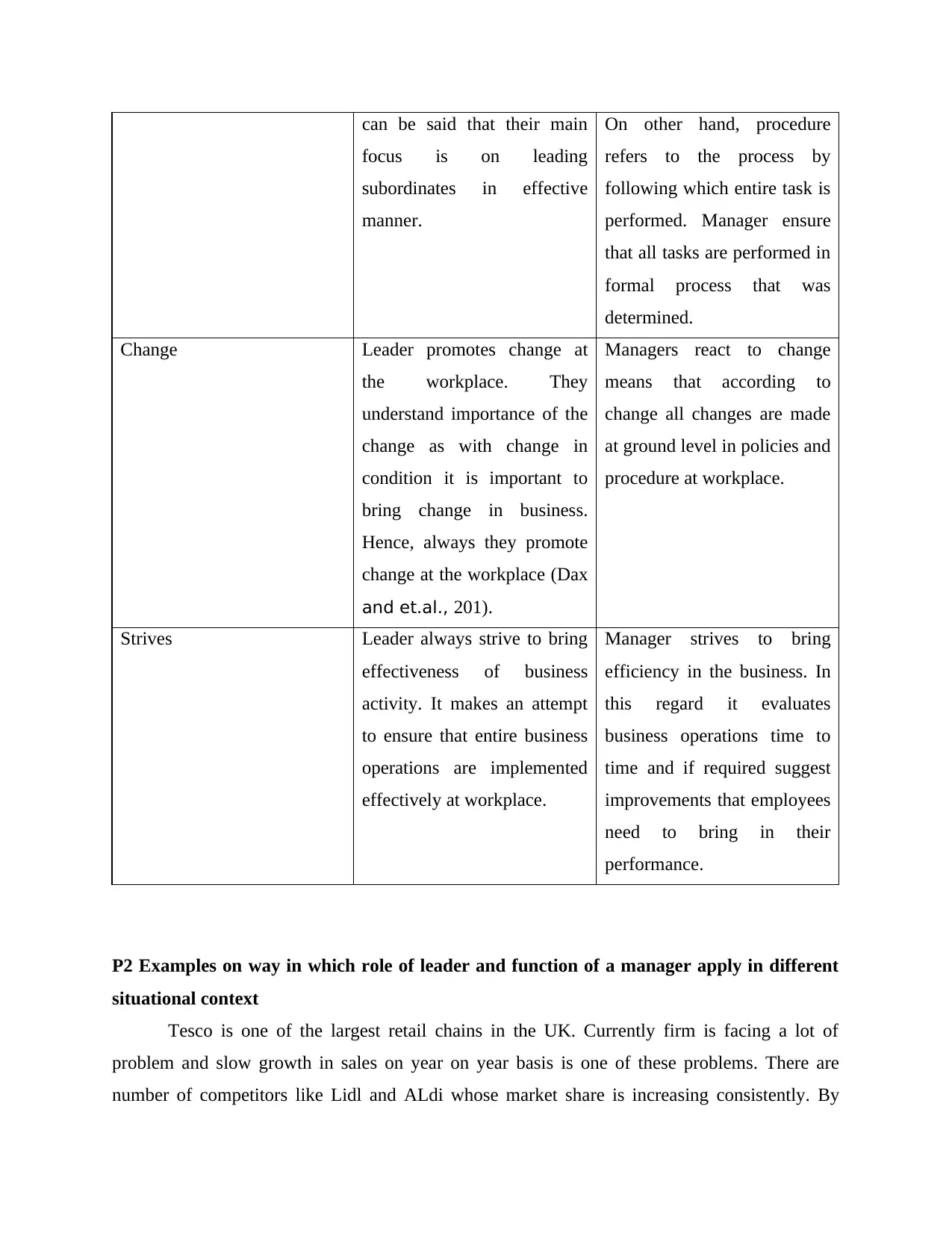
can be said that their main
focus is on leading
subordinates in effective
manner.
On other hand, procedure
refers to the process by
following which entire task is
performed. Manager ensure
that all tasks are performed in
formal process that was
determined.
Change Leader promotes change at
the workplace. They
understand importance of the
change as with change in
condition it is important to
bring change in business.
Hence, always they promote
change at the workplace (Dax
and et.al., 201).
Managers react to change
means that according to
change all changes are made
at ground level in policies and
procedure at workplace.
Strives Leader always strive to bring
effectiveness of business
activity. It makes an attempt
to ensure that entire business
operations are implemented
effectively at workplace.
Manager strives to bring
efficiency in the business. In
this regard it evaluates
business operations time to
time and if required suggest
improvements that employees
need to bring in their
performance.
P2 Examples on way in which role of leader and function of a manager apply in different
situational context
Tesco is one of the largest retail chains in the UK. Currently firm is facing a lot of
problem and slow growth in sales on year on year basis is one of these problems. There are
number of competitors like Lidl and ALdi whose market share is increasing consistently. By
focus is on leading
subordinates in effective
manner.
On other hand, procedure
refers to the process by
following which entire task is
performed. Manager ensure
that all tasks are performed in
formal process that was
determined.
Change Leader promotes change at
the workplace. They
understand importance of the
change as with change in
condition it is important to
bring change in business.
Hence, always they promote
change at the workplace (Dax
and et.al., 201).
Managers react to change
means that according to
change all changes are made
at ground level in policies and
procedure at workplace.
Strives Leader always strive to bring
effectiveness of business
activity. It makes an attempt
to ensure that entire business
operations are implemented
effectively at workplace.
Manager strives to bring
efficiency in the business. In
this regard it evaluates
business operations time to
time and if required suggest
improvements that employees
need to bring in their
performance.
P2 Examples on way in which role of leader and function of a manager apply in different
situational context
Tesco is one of the largest retail chains in the UK. Currently firm is facing a lot of
problem and slow growth in sales on year on year basis is one of these problems. There are
number of competitors like Lidl and ALdi whose market share is increasing consistently. By
⊘ This is a preview!⊘
Do you want full access?
Subscribe today to unlock all pages.

Trusted by 1+ million students worldwide
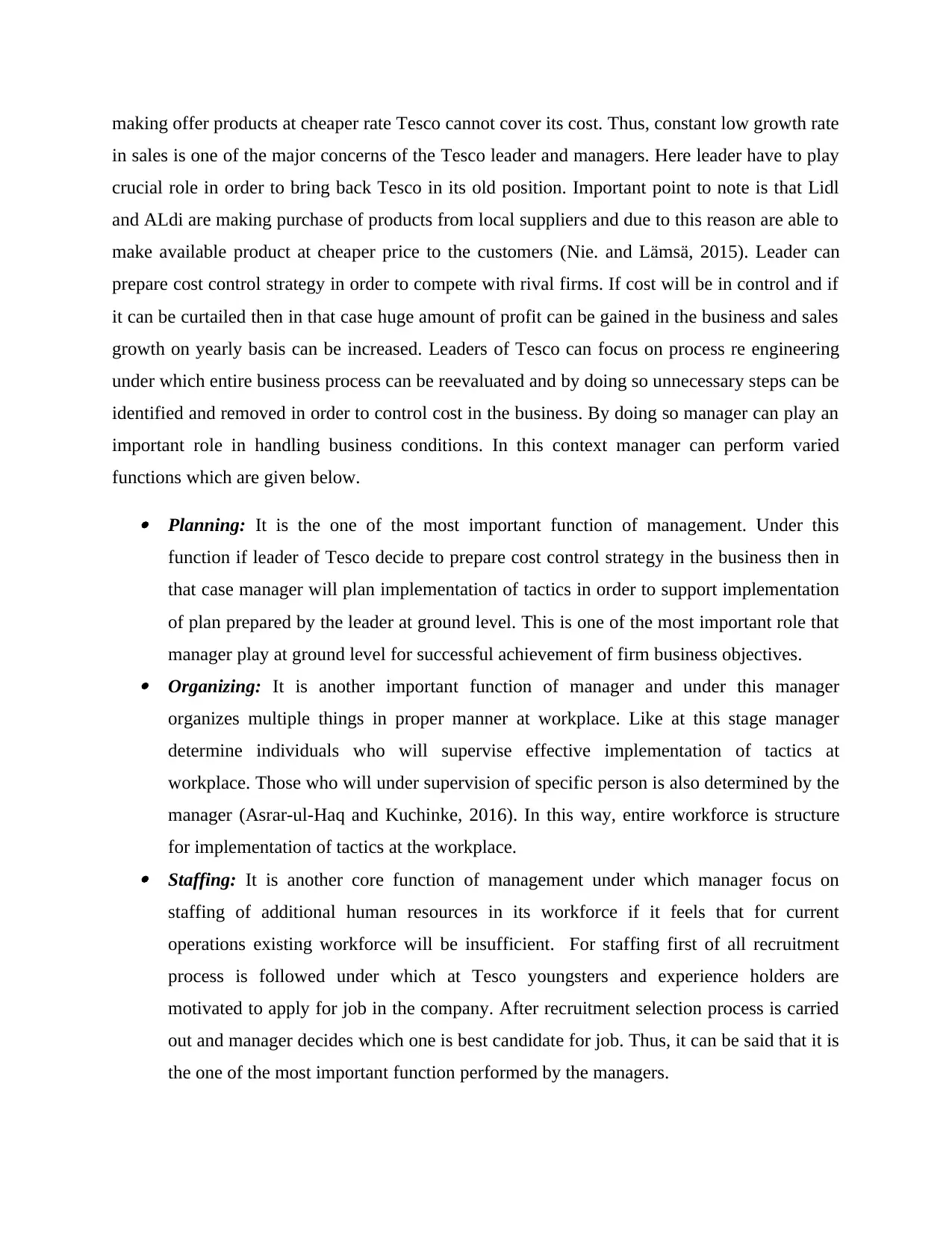
making offer products at cheaper rate Tesco cannot cover its cost. Thus, constant low growth rate
in sales is one of the major concerns of the Tesco leader and managers. Here leader have to play
crucial role in order to bring back Tesco in its old position. Important point to note is that Lidl
and ALdi are making purchase of products from local suppliers and due to this reason are able to
make available product at cheaper price to the customers (Nie. and Lämsä, 2015). Leader can
prepare cost control strategy in order to compete with rival firms. If cost will be in control and if
it can be curtailed then in that case huge amount of profit can be gained in the business and sales
growth on yearly basis can be increased. Leaders of Tesco can focus on process re engineering
under which entire business process can be reevaluated and by doing so unnecessary steps can be
identified and removed in order to control cost in the business. By doing so manager can play an
important role in handling business conditions. In this context manager can perform varied
functions which are given below.
Planning: It is the one of the most important function of management. Under this
function if leader of Tesco decide to prepare cost control strategy in the business then in
that case manager will plan implementation of tactics in order to support implementation
of plan prepared by the leader at ground level. This is one of the most important role that
manager play at ground level for successful achievement of firm business objectives. Organizing: It is another important function of manager and under this manager
organizes multiple things in proper manner at workplace. Like at this stage manager
determine individuals who will supervise effective implementation of tactics at
workplace. Those who will under supervision of specific person is also determined by the
manager (Asrar-ul-Haq and Kuchinke, 2016). In this way, entire workforce is structure
for implementation of tactics at the workplace. Staffing: It is another core function of management under which manager focus on
staffing of additional human resources in its workforce if it feels that for current
operations existing workforce will be insufficient. For staffing first of all recruitment
process is followed under which at Tesco youngsters and experience holders are
motivated to apply for job in the company. After recruitment selection process is carried
out and manager decides which one is best candidate for job. Thus, it can be said that it is
the one of the most important function performed by the managers.
in sales is one of the major concerns of the Tesco leader and managers. Here leader have to play
crucial role in order to bring back Tesco in its old position. Important point to note is that Lidl
and ALdi are making purchase of products from local suppliers and due to this reason are able to
make available product at cheaper price to the customers (Nie. and Lämsä, 2015). Leader can
prepare cost control strategy in order to compete with rival firms. If cost will be in control and if
it can be curtailed then in that case huge amount of profit can be gained in the business and sales
growth on yearly basis can be increased. Leaders of Tesco can focus on process re engineering
under which entire business process can be reevaluated and by doing so unnecessary steps can be
identified and removed in order to control cost in the business. By doing so manager can play an
important role in handling business conditions. In this context manager can perform varied
functions which are given below.
Planning: It is the one of the most important function of management. Under this
function if leader of Tesco decide to prepare cost control strategy in the business then in
that case manager will plan implementation of tactics in order to support implementation
of plan prepared by the leader at ground level. This is one of the most important role that
manager play at ground level for successful achievement of firm business objectives. Organizing: It is another important function of manager and under this manager
organizes multiple things in proper manner at workplace. Like at this stage manager
determine individuals who will supervise effective implementation of tactics at
workplace. Those who will under supervision of specific person is also determined by the
manager (Asrar-ul-Haq and Kuchinke, 2016). In this way, entire workforce is structure
for implementation of tactics at the workplace. Staffing: It is another core function of management under which manager focus on
staffing of additional human resources in its workforce if it feels that for current
operations existing workforce will be insufficient. For staffing first of all recruitment
process is followed under which at Tesco youngsters and experience holders are
motivated to apply for job in the company. After recruitment selection process is carried
out and manager decides which one is best candidate for job. Thus, it can be said that it is
the one of the most important function performed by the managers.
Paraphrase This Document
Need a fresh take? Get an instant paraphrase of this document with our AI Paraphraser
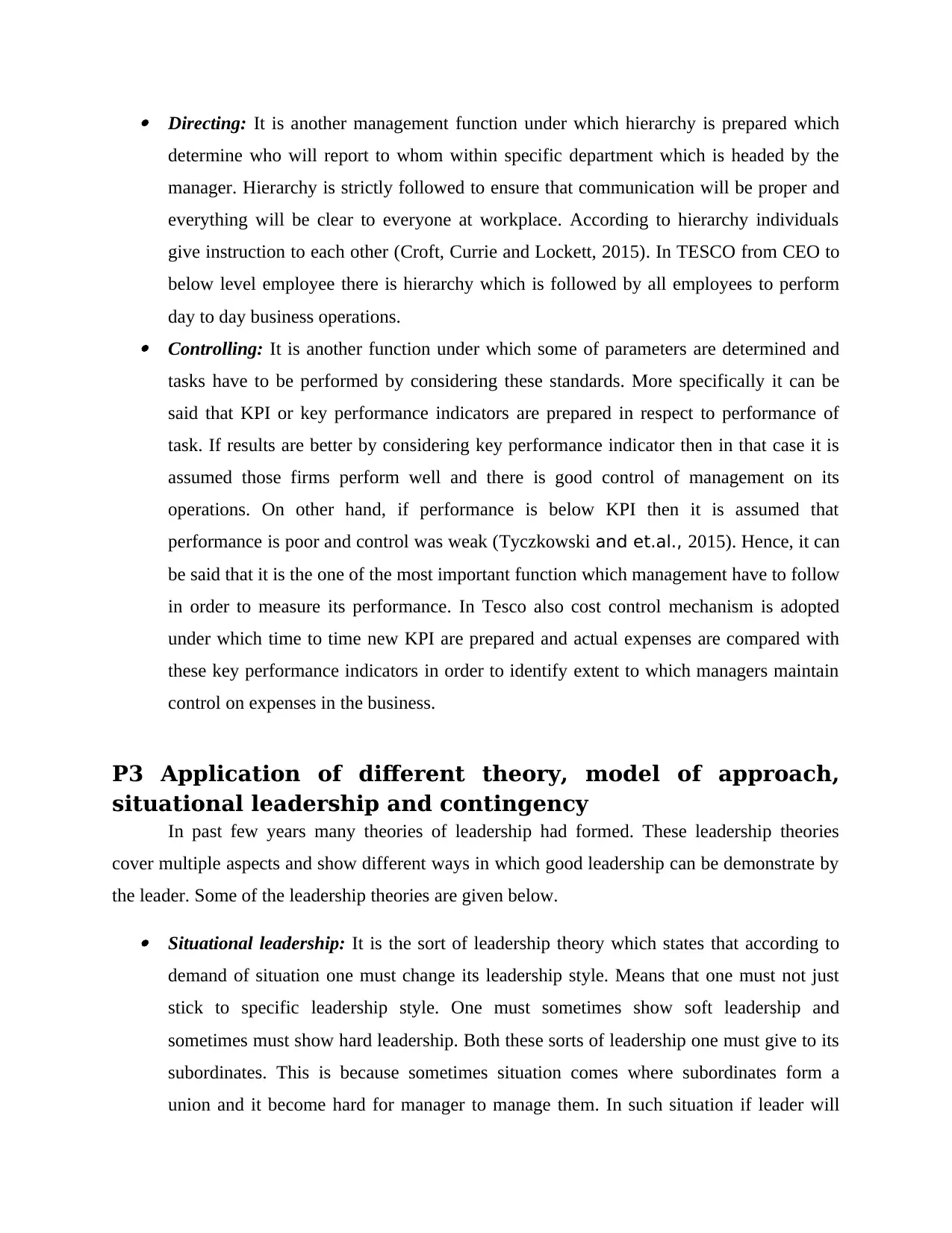
Directing: It is another management function under which hierarchy is prepared which
determine who will report to whom within specific department which is headed by the
manager. Hierarchy is strictly followed to ensure that communication will be proper and
everything will be clear to everyone at workplace. According to hierarchy individuals
give instruction to each other (Croft, Currie and Lockett, 2015). In TESCO from CEO to
below level employee there is hierarchy which is followed by all employees to perform
day to day business operations. Controlling: It is another function under which some of parameters are determined and
tasks have to be performed by considering these standards. More specifically it can be
said that KPI or key performance indicators are prepared in respect to performance of
task. If results are better by considering key performance indicator then in that case it is
assumed those firms perform well and there is good control of management on its
operations. On other hand, if performance is below KPI then it is assumed that
performance is poor and control was weak (Tyczkowski and et.al., 2015). Hence, it can
be said that it is the one of the most important function which management have to follow
in order to measure its performance. In Tesco also cost control mechanism is adopted
under which time to time new KPI are prepared and actual expenses are compared with
these key performance indicators in order to identify extent to which managers maintain
control on expenses in the business.
P3 Application of different theory, model of approach,
situational leadership and contingency
In past few years many theories of leadership had formed. These leadership theories
cover multiple aspects and show different ways in which good leadership can be demonstrate by
the leader. Some of the leadership theories are given below.
Situational leadership: It is the sort of leadership theory which states that according to
demand of situation one must change its leadership style. Means that one must not just
stick to specific leadership style. One must sometimes show soft leadership and
sometimes must show hard leadership. Both these sorts of leadership one must give to its
subordinates. This is because sometimes situation comes where subordinates form a
union and it become hard for manager to manage them. In such situation if leader will
determine who will report to whom within specific department which is headed by the
manager. Hierarchy is strictly followed to ensure that communication will be proper and
everything will be clear to everyone at workplace. According to hierarchy individuals
give instruction to each other (Croft, Currie and Lockett, 2015). In TESCO from CEO to
below level employee there is hierarchy which is followed by all employees to perform
day to day business operations. Controlling: It is another function under which some of parameters are determined and
tasks have to be performed by considering these standards. More specifically it can be
said that KPI or key performance indicators are prepared in respect to performance of
task. If results are better by considering key performance indicator then in that case it is
assumed those firms perform well and there is good control of management on its
operations. On other hand, if performance is below KPI then it is assumed that
performance is poor and control was weak (Tyczkowski and et.al., 2015). Hence, it can
be said that it is the one of the most important function which management have to follow
in order to measure its performance. In Tesco also cost control mechanism is adopted
under which time to time new KPI are prepared and actual expenses are compared with
these key performance indicators in order to identify extent to which managers maintain
control on expenses in the business.
P3 Application of different theory, model of approach,
situational leadership and contingency
In past few years many theories of leadership had formed. These leadership theories
cover multiple aspects and show different ways in which good leadership can be demonstrate by
the leader. Some of the leadership theories are given below.
Situational leadership: It is the sort of leadership theory which states that according to
demand of situation one must change its leadership style. Means that one must not just
stick to specific leadership style. One must sometimes show soft leadership and
sometimes must show hard leadership. Both these sorts of leadership one must give to its
subordinates. This is because sometimes situation comes where subordinates form a
union and it become hard for manager to manage them. In such situation if leader will
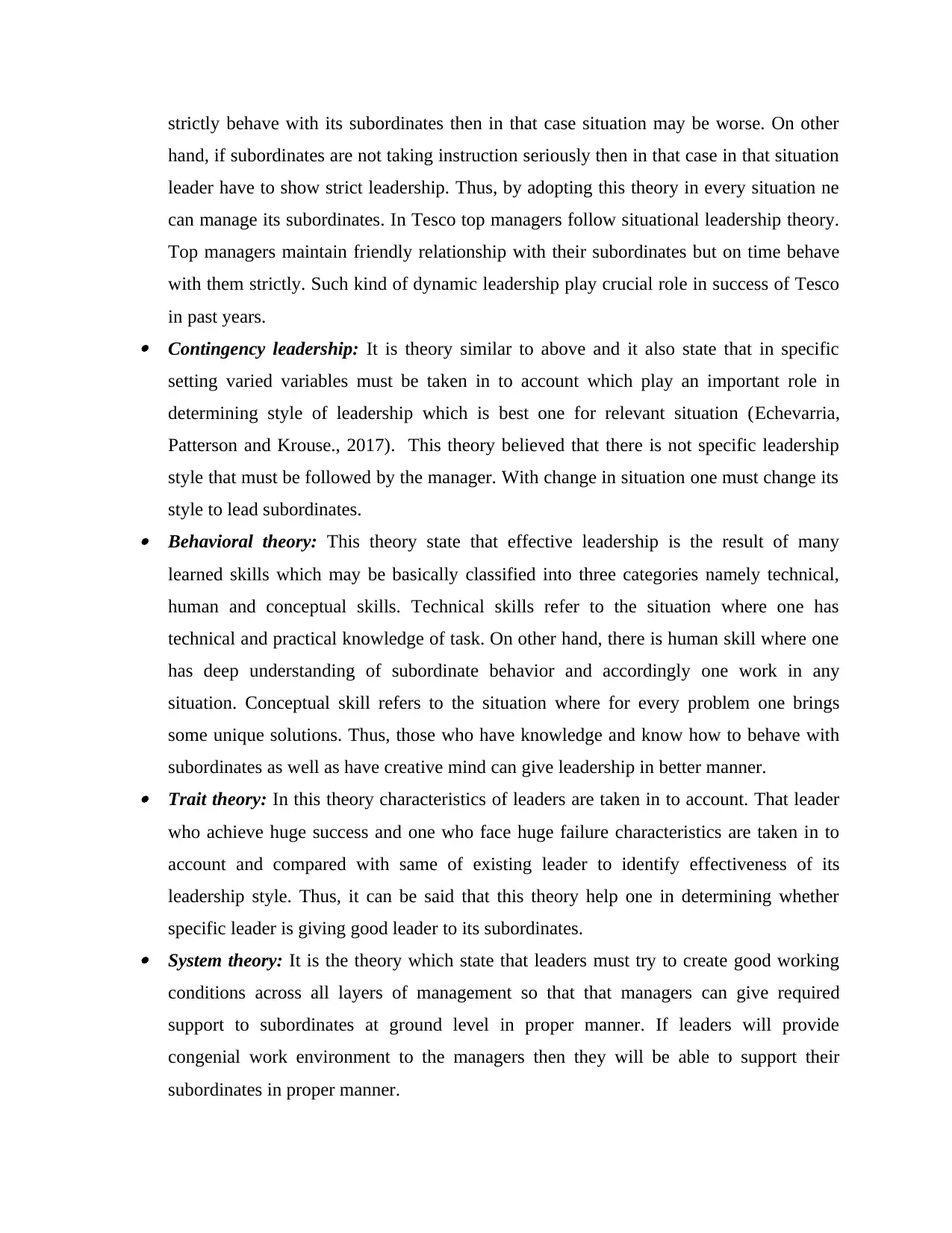
strictly behave with its subordinates then in that case situation may be worse. On other
hand, if subordinates are not taking instruction seriously then in that case in that situation
leader have to show strict leadership. Thus, by adopting this theory in every situation ne
can manage its subordinates. In Tesco top managers follow situational leadership theory.
Top managers maintain friendly relationship with their subordinates but on time behave
with them strictly. Such kind of dynamic leadership play crucial role in success of Tesco
in past years. Contingency leadership: It is theory similar to above and it also state that in specific
setting varied variables must be taken in to account which play an important role in
determining style of leadership which is best one for relevant situation (Echevarria,
Patterson and Krouse., 2017). This theory believed that there is not specific leadership
style that must be followed by the manager. With change in situation one must change its
style to lead subordinates. Behavioral theory: This theory state that effective leadership is the result of many
learned skills which may be basically classified into three categories namely technical,
human and conceptual skills. Technical skills refer to the situation where one has
technical and practical knowledge of task. On other hand, there is human skill where one
has deep understanding of subordinate behavior and accordingly one work in any
situation. Conceptual skill refers to the situation where for every problem one brings
some unique solutions. Thus, those who have knowledge and know how to behave with
subordinates as well as have creative mind can give leadership in better manner. Trait theory: In this theory characteristics of leaders are taken in to account. That leader
who achieve huge success and one who face huge failure characteristics are taken in to
account and compared with same of existing leader to identify effectiveness of its
leadership style. Thus, it can be said that this theory help one in determining whether
specific leader is giving good leader to its subordinates. System theory: It is the theory which state that leaders must try to create good working
conditions across all layers of management so that that managers can give required
support to subordinates at ground level in proper manner. If leaders will provide
congenial work environment to the managers then they will be able to support their
subordinates in proper manner.
hand, if subordinates are not taking instruction seriously then in that case in that situation
leader have to show strict leadership. Thus, by adopting this theory in every situation ne
can manage its subordinates. In Tesco top managers follow situational leadership theory.
Top managers maintain friendly relationship with their subordinates but on time behave
with them strictly. Such kind of dynamic leadership play crucial role in success of Tesco
in past years. Contingency leadership: It is theory similar to above and it also state that in specific
setting varied variables must be taken in to account which play an important role in
determining style of leadership which is best one for relevant situation (Echevarria,
Patterson and Krouse., 2017). This theory believed that there is not specific leadership
style that must be followed by the manager. With change in situation one must change its
style to lead subordinates. Behavioral theory: This theory state that effective leadership is the result of many
learned skills which may be basically classified into three categories namely technical,
human and conceptual skills. Technical skills refer to the situation where one has
technical and practical knowledge of task. On other hand, there is human skill where one
has deep understanding of subordinate behavior and accordingly one work in any
situation. Conceptual skill refers to the situation where for every problem one brings
some unique solutions. Thus, those who have knowledge and know how to behave with
subordinates as well as have creative mind can give leadership in better manner. Trait theory: In this theory characteristics of leaders are taken in to account. That leader
who achieve huge success and one who face huge failure characteristics are taken in to
account and compared with same of existing leader to identify effectiveness of its
leadership style. Thus, it can be said that this theory help one in determining whether
specific leader is giving good leader to its subordinates. System theory: It is the theory which state that leaders must try to create good working
conditions across all layers of management so that that managers can give required
support to subordinates at ground level in proper manner. If leaders will provide
congenial work environment to the managers then they will be able to support their
subordinates in proper manner.
⊘ This is a preview!⊘
Do you want full access?
Subscribe today to unlock all pages.

Trusted by 1+ million students worldwide
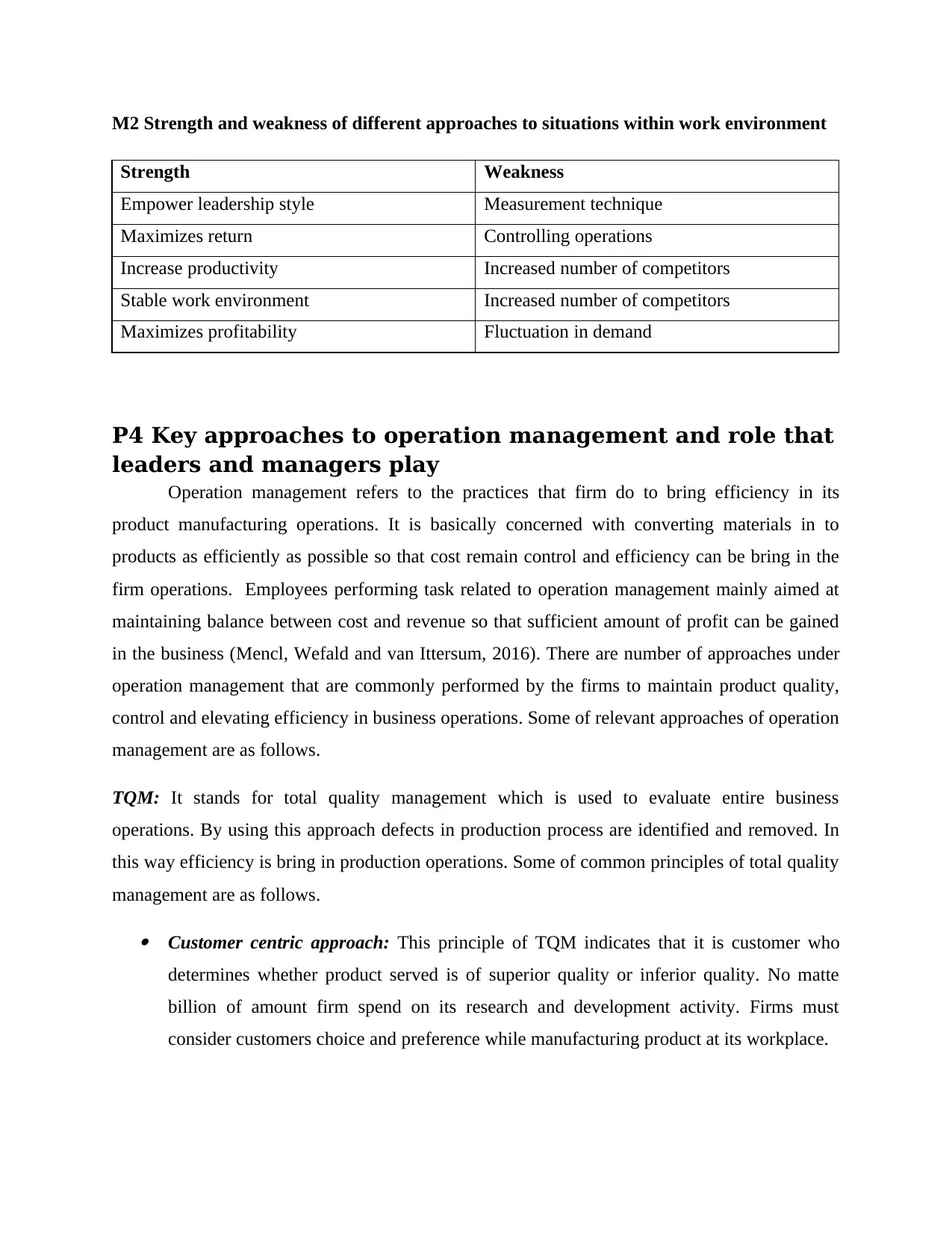
M2 Strength and weakness of different approaches to situations within work environment
Strength Weakness
Empower leadership style Measurement technique
Maximizes return Controlling operations
Increase productivity Increased number of competitors
Stable work environment Increased number of competitors
Maximizes profitability Fluctuation in demand
P4 Key approaches to operation management and role that
leaders and managers play
Operation management refers to the practices that firm do to bring efficiency in its
product manufacturing operations. It is basically concerned with converting materials in to
products as efficiently as possible so that cost remain control and efficiency can be bring in the
firm operations. Employees performing task related to operation management mainly aimed at
maintaining balance between cost and revenue so that sufficient amount of profit can be gained
in the business (Mencl, Wefald and van Ittersum, 2016). There are number of approaches under
operation management that are commonly performed by the firms to maintain product quality,
control and elevating efficiency in business operations. Some of relevant approaches of operation
management are as follows.
TQM: It stands for total quality management which is used to evaluate entire business
operations. By using this approach defects in production process are identified and removed. In
this way efficiency is bring in production operations. Some of common principles of total quality
management are as follows.
Customer centric approach: This principle of TQM indicates that it is customer who
determines whether product served is of superior quality or inferior quality. No matte
billion of amount firm spend on its research and development activity. Firms must
consider customers choice and preference while manufacturing product at its workplace.
Strength Weakness
Empower leadership style Measurement technique
Maximizes return Controlling operations
Increase productivity Increased number of competitors
Stable work environment Increased number of competitors
Maximizes profitability Fluctuation in demand
P4 Key approaches to operation management and role that
leaders and managers play
Operation management refers to the practices that firm do to bring efficiency in its
product manufacturing operations. It is basically concerned with converting materials in to
products as efficiently as possible so that cost remain control and efficiency can be bring in the
firm operations. Employees performing task related to operation management mainly aimed at
maintaining balance between cost and revenue so that sufficient amount of profit can be gained
in the business (Mencl, Wefald and van Ittersum, 2016). There are number of approaches under
operation management that are commonly performed by the firms to maintain product quality,
control and elevating efficiency in business operations. Some of relevant approaches of operation
management are as follows.
TQM: It stands for total quality management which is used to evaluate entire business
operations. By using this approach defects in production process are identified and removed. In
this way efficiency is bring in production operations. Some of common principles of total quality
management are as follows.
Customer centric approach: This principle of TQM indicates that it is customer who
determines whether product served is of superior quality or inferior quality. No matte
billion of amount firm spend on its research and development activity. Firms must
consider customers choice and preference while manufacturing product at its workplace.
Paraphrase This Document
Need a fresh take? Get an instant paraphrase of this document with our AI Paraphraser
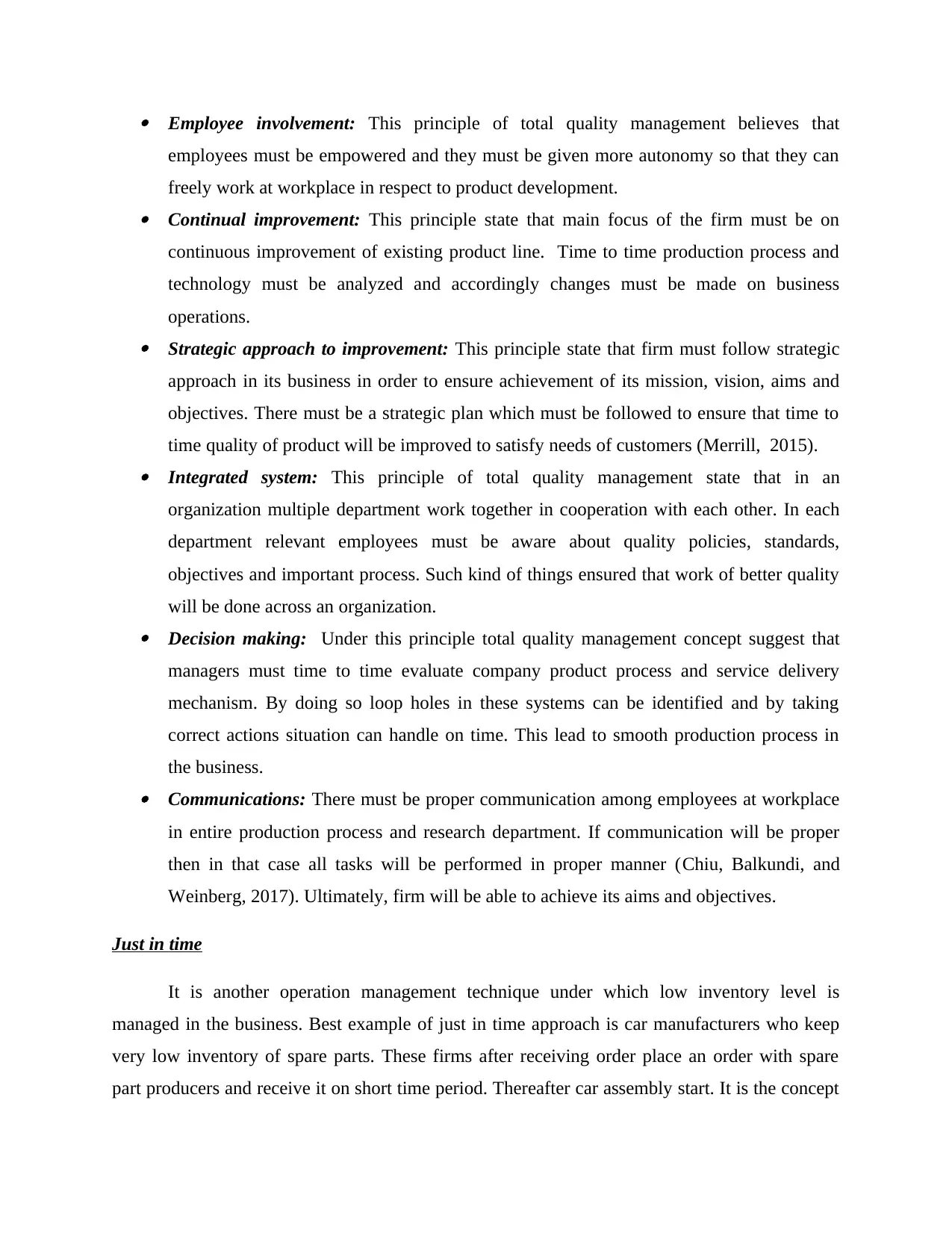
Employee involvement: This principle of total quality management believes that
employees must be empowered and they must be given more autonomy so that they can
freely work at workplace in respect to product development. Continual improvement: This principle state that main focus of the firm must be on
continuous improvement of existing product line. Time to time production process and
technology must be analyzed and accordingly changes must be made on business
operations. Strategic approach to improvement: This principle state that firm must follow strategic
approach in its business in order to ensure achievement of its mission, vision, aims and
objectives. There must be a strategic plan which must be followed to ensure that time to
time quality of product will be improved to satisfy needs of customers (Merrill, 2015). Integrated system: This principle of total quality management state that in an
organization multiple department work together in cooperation with each other. In each
department relevant employees must be aware about quality policies, standards,
objectives and important process. Such kind of things ensured that work of better quality
will be done across an organization. Decision making: Under this principle total quality management concept suggest that
managers must time to time evaluate company product process and service delivery
mechanism. By doing so loop holes in these systems can be identified and by taking
correct actions situation can handle on time. This lead to smooth production process in
the business. Communications: There must be proper communication among employees at workplace
in entire production process and research department. If communication will be proper
then in that case all tasks will be performed in proper manner (Chiu, Balkundi, and
Weinberg, 2017). Ultimately, firm will be able to achieve its aims and objectives.
Just in time
It is another operation management technique under which low inventory level is
managed in the business. Best example of just in time approach is car manufacturers who keep
very low inventory of spare parts. These firms after receiving order place an order with spare
part producers and receive it on short time period. Thereafter car assembly start. It is the concept
employees must be empowered and they must be given more autonomy so that they can
freely work at workplace in respect to product development. Continual improvement: This principle state that main focus of the firm must be on
continuous improvement of existing product line. Time to time production process and
technology must be analyzed and accordingly changes must be made on business
operations. Strategic approach to improvement: This principle state that firm must follow strategic
approach in its business in order to ensure achievement of its mission, vision, aims and
objectives. There must be a strategic plan which must be followed to ensure that time to
time quality of product will be improved to satisfy needs of customers (Merrill, 2015). Integrated system: This principle of total quality management state that in an
organization multiple department work together in cooperation with each other. In each
department relevant employees must be aware about quality policies, standards,
objectives and important process. Such kind of things ensured that work of better quality
will be done across an organization. Decision making: Under this principle total quality management concept suggest that
managers must time to time evaluate company product process and service delivery
mechanism. By doing so loop holes in these systems can be identified and by taking
correct actions situation can handle on time. This lead to smooth production process in
the business. Communications: There must be proper communication among employees at workplace
in entire production process and research department. If communication will be proper
then in that case all tasks will be performed in proper manner (Chiu, Balkundi, and
Weinberg, 2017). Ultimately, firm will be able to achieve its aims and objectives.
Just in time
It is another operation management technique under which low inventory level is
managed in the business. Best example of just in time approach is car manufacturers who keep
very low inventory of spare parts. These firms after receiving order place an order with spare
part producers and receive it on short time period. Thereafter car assembly start. It is the concept
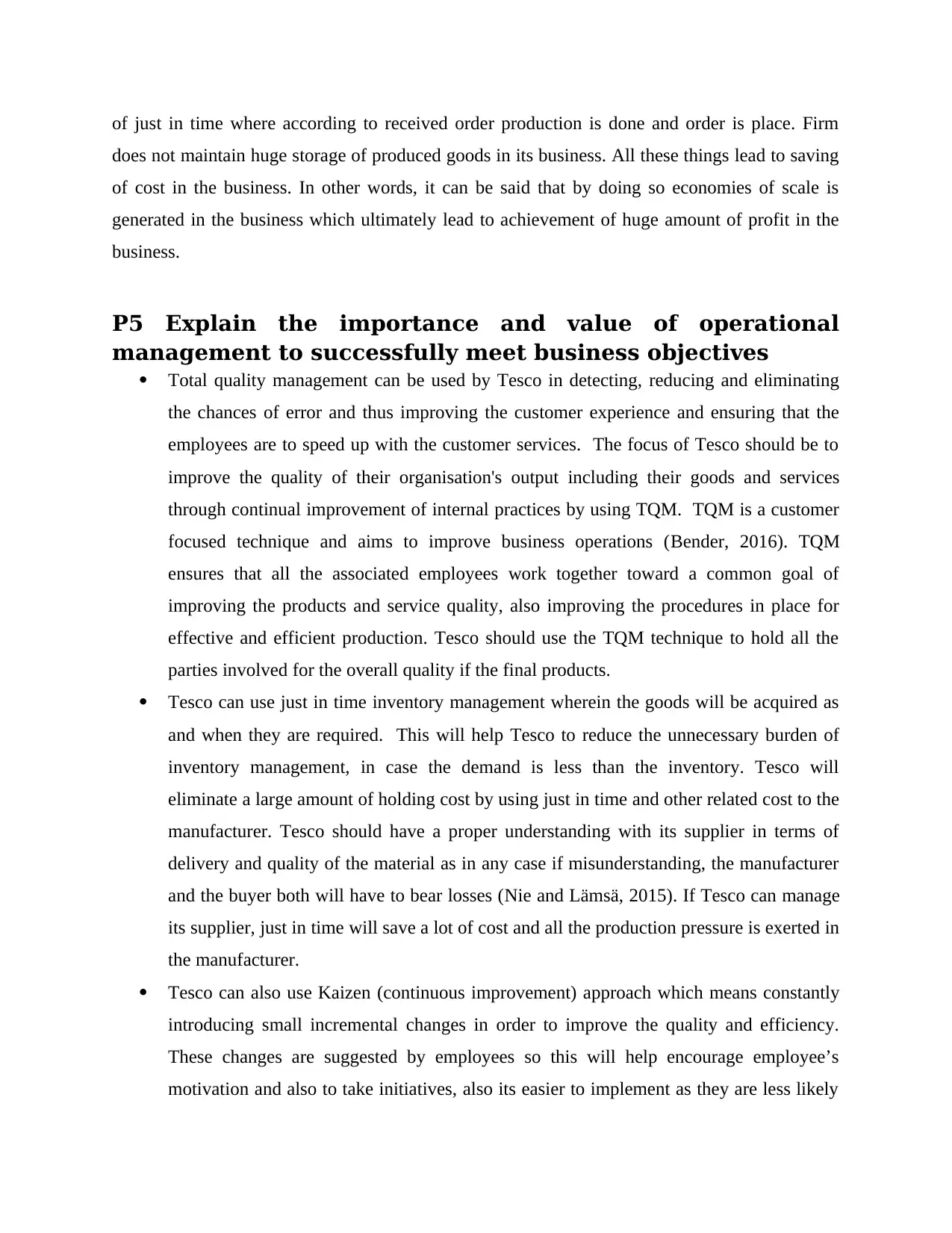
of just in time where according to received order production is done and order is place. Firm
does not maintain huge storage of produced goods in its business. All these things lead to saving
of cost in the business. In other words, it can be said that by doing so economies of scale is
generated in the business which ultimately lead to achievement of huge amount of profit in the
business.
P5 Explain the importance and value of operational
management to successfully meet business objectives
Total quality management can be used by Tesco in detecting, reducing and eliminating
the chances of error and thus improving the customer experience and ensuring that the
employees are to speed up with the customer services. The focus of Tesco should be to
improve the quality of their organisation's output including their goods and services
through continual improvement of internal practices by using TQM. TQM is a customer
focused technique and aims to improve business operations (Bender, 2016). TQM
ensures that all the associated employees work together toward a common goal of
improving the products and service quality, also improving the procedures in place for
effective and efficient production. Tesco should use the TQM technique to hold all the
parties involved for the overall quality if the final products.
Tesco can use just in time inventory management wherein the goods will be acquired as
and when they are required. This will help Tesco to reduce the unnecessary burden of
inventory management, in case the demand is less than the inventory. Tesco will
eliminate a large amount of holding cost by using just in time and other related cost to the
manufacturer. Tesco should have a proper understanding with its supplier in terms of
delivery and quality of the material as in any case if misunderstanding, the manufacturer
and the buyer both will have to bear losses (Nie and Lämsä, 2015). If Tesco can manage
its supplier, just in time will save a lot of cost and all the production pressure is exerted in
the manufacturer.
Tesco can also use Kaizen (continuous improvement) approach which means constantly
introducing small incremental changes in order to improve the quality and efficiency.
These changes are suggested by employees so this will help encourage employee’s
motivation and also to take initiatives, also its easier to implement as they are less likely
does not maintain huge storage of produced goods in its business. All these things lead to saving
of cost in the business. In other words, it can be said that by doing so economies of scale is
generated in the business which ultimately lead to achievement of huge amount of profit in the
business.
P5 Explain the importance and value of operational
management to successfully meet business objectives
Total quality management can be used by Tesco in detecting, reducing and eliminating
the chances of error and thus improving the customer experience and ensuring that the
employees are to speed up with the customer services. The focus of Tesco should be to
improve the quality of their organisation's output including their goods and services
through continual improvement of internal practices by using TQM. TQM is a customer
focused technique and aims to improve business operations (Bender, 2016). TQM
ensures that all the associated employees work together toward a common goal of
improving the products and service quality, also improving the procedures in place for
effective and efficient production. Tesco should use the TQM technique to hold all the
parties involved for the overall quality if the final products.
Tesco can use just in time inventory management wherein the goods will be acquired as
and when they are required. This will help Tesco to reduce the unnecessary burden of
inventory management, in case the demand is less than the inventory. Tesco will
eliminate a large amount of holding cost by using just in time and other related cost to the
manufacturer. Tesco should have a proper understanding with its supplier in terms of
delivery and quality of the material as in any case if misunderstanding, the manufacturer
and the buyer both will have to bear losses (Nie and Lämsä, 2015). If Tesco can manage
its supplier, just in time will save a lot of cost and all the production pressure is exerted in
the manufacturer.
Tesco can also use Kaizen (continuous improvement) approach which means constantly
introducing small incremental changes in order to improve the quality and efficiency.
These changes are suggested by employees so this will help encourage employee’s
motivation and also to take initiatives, also its easier to implement as they are less likely
⊘ This is a preview!⊘
Do you want full access?
Subscribe today to unlock all pages.

Trusted by 1+ million students worldwide
1 out of 16
Related Documents
Your All-in-One AI-Powered Toolkit for Academic Success.
+13062052269
info@desklib.com
Available 24*7 on WhatsApp / Email
![[object Object]](/_next/static/media/star-bottom.7253800d.svg)
Unlock your academic potential
Copyright © 2020–2025 A2Z Services. All Rights Reserved. Developed and managed by ZUCOL.





